Universal Credit and Child Tax Credit claimants: statistics related to the policy to provide support for a maximum of 2 children, April 2022
Published 14 July 2022
Main Stories
The statistics show:
- On 2 April 2022, there were 359 thousand households that had a third or subsequent child born on or after 6 April 2017 that were not receiving the child element of Universal Credit or Child Tax Credit because of the policy to provide support for a maximum of two children.
- There were a total of 1.3 million children living in a household that was not receiving a child element or amount for at least one child due to being affected by the policy.
- 17 thousand households that had a third or subsequent child born on or after 6 April 2017 were in receipt of an exception.
- The most common reason for an exception was for multiple births (12 thousand or 71 per cent of those with an exception).
- The number of households affected by the policy has increased since the first statistics were published in 2018, as more children have been born into families with 2 existing children.
Guidance
Note that figures may not sum due to rounding.
Guidance on these statistics is available in the background information and methodology document.
Overall numbers of households affected by the policy to provide support for a maximum of two children
As of 2 April 2022, there were in total around 787 thousand households with three or more children claiming either Universal Credit (416 thousand) or Child Tax Credit (371 thousand).
Of these, a total of 370 thousand households across UC and CTC were affected by the policy to provide support for a maximum of two children (Table 1). Around 359 thousand (97 per cent) were not receiving a child element or amount for at least one child in their household. Around 17 thousand households (5 per cent) were receiving an exception to the policy.
The majority of households affected were in receipt of UC (65 per cent). The proportion of UC households in the total is expected to rise over time as UC continues to roll out whereas the proportion of CTC households is expected to fall.
The 370 thousand households affected by the policy represents 47 per cent of all households with a third or subsequent child claiming UC or CTC. This proportion will grow over time as more households with three or more children will include a child born on or after 6 April 2017.
Table 1: Total number of households in receipt of Universal Credit or Child Tax Credit affected by the policy to provide support for a maximum of two children, 2 April 2022
| Total | Universal Credit | Child Tax Credit | |
|---|---|---|---|
| All households in receipt of UC or CTC with three or more children | 786,870 | 415,780 | 371,100 |
| Affected households (reporting a third or subsequent child on or after 6 April 2017) | 369,910 | 239,580 | 130,330 |
| Households not receiving a child element/amount for at least one child | 359,250 | 232,150 | 127,100 |
| Households in receipt of an exception | 16,920 | 11,490 | 5,430 |
Note: Universal Credit figures are for GB only (as DWP do not administer Universal Credit in Northern Ireland), whereas the Child Tax Credit figures are on a UK basis.
Note: The Affected households figures do not equal the sum of the two components below as there are households both not receiving a child element/amount for one child and in receipt of an exception for another child.
Overall numbers of households with an exception
On 2 April 2022, around 11 thousand households claiming Universal Credit and around 5 thousand households claiming Child Tax Credit were in receipt of at least one exception (Table 2).
Across both UC and CTC, 12 thousand households (71 per cent of all those with an exception) were in receipt of a multiple birth exception. Around 2 thousand households, or 14 per cent of households with an exception, received a non-parental care exception. About 4 per cent of households with an exception were received due to adoption and about 2 thousand households (11 per cent of households with an exception) received a non-consensual conception exception.
Table 2: Number of households in receipt of Universal Credit or Child Tax Credit with an exception to the policy to provide support for a maximum of two children, by category, 2 April 2022
| Total | Universal Credit | Child Tax Credit | |
|---|---|---|---|
| Total - Households in receipt of an exception | 16,920 | 11,490 | 5,430 |
| Multiple birth | 12,000 | 8,160 | 3,850 |
| Non-parental care | 2,390 | 1,520 | 870 |
| Adoption | 720 | 620 | 100 |
| Non-consensual conception | 1,830 | 1,220 | 610 |
Note: Universal Credit figures are for GB only (as DWP do not administer Universal Credit in Northern Ireland), whereas the Child Tax Credit figures are on a UK basis.
Note: The Total does not equal the sum of the components as there are a number of households that have exceptions in more than one category. They are counted once in each appropriate category but only once in the total.
Households affected by the policy to provide support for a maximum of two children, by work status
“In work” is defined as eligible for Working Tax Credit within the tax credit system, or in receipt of employment income within Universal Credit. 58 per cent of claimants affected by the policy, or 216 thousand, are classified as in-work (Figure 1).
64 per cent of Child Tax Credit Claimants affected by the policy are in work; a higher proportion than UC (55 per cent).
A slightly lower proportion of households with an exception are in-work (52 per cent) compared to those without an exception for at least one child (59 per cent).
Figure 1: Households affected by the policy to provide support for a maximum of two children, by work status, 2 April 2022
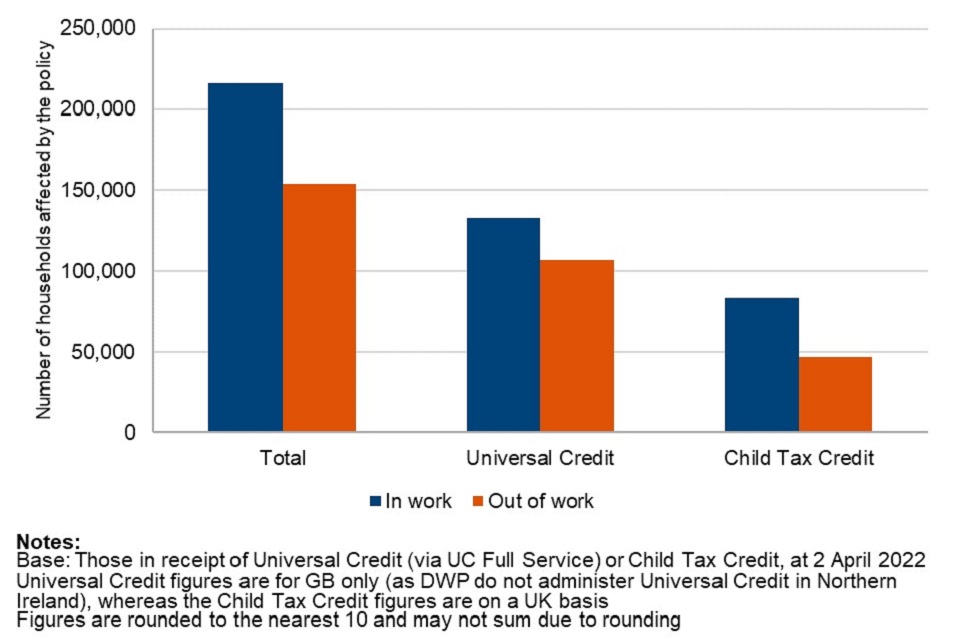
Households affected by the policy to provide support for a maximum of two children, by number of adults
53 per cent of households affected by the policy, or 195 thousand, have two adults in the household (Figure 2). The remainder are single adult households. The proportion of couples is higher in Child Tax Credit (63 per cent) than in Universal Credit (47 per cent). This reflects the composition of the UC population at this stage of its growth.
Figure 2: Households affected by the policy to provide support for a maximum of two children, by number of adults, 2 April 2022

Households affected by the policy to provide support for a maximum of two children, by country
Around 325 thousand (88 per cent) of those in GB Universal Credit households and UK Child Tax Credit households affected by the policy were residents in England in April 2022 (Figures 3 and 4). 22 thousand (6 per cent) were residents in Scotland and 17 thousand (5 per cent) in Wales. Nearly 6 thousand (2 per cent) were CTC recipients in Northern Ireland. A small number of CTC claimants (less than 1 thousand) were either resident abroad or their country could not be identified from the data.
Around 5 per cent of households in England who were affected by the policy were in receipt of an exception in April 2022. About 6 per cent of households affected in Scotland received an exception, as did 5 per cent of households in Wales and 4 per cent of CTC households in Northern Ireland.
These figures reflect areas of responsibility of the Department for Work and Pensions and HM Revenue & Customs. Consequently, UC statistics relate to Great Britain whereas statistics on CTC relate to the United Kingdom.
Figure 3: Households affected by the policy to provide support for a maximum of two children, by country, 2 April 2022
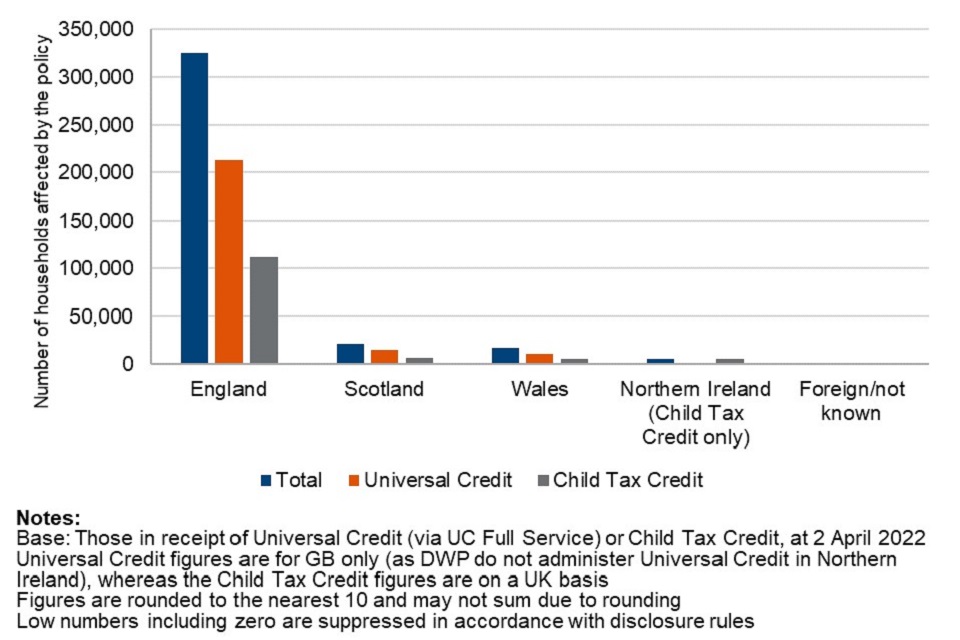
Figure 4: Proportion of households affected by the policy to provide support for a maximum of two children, by country, 2 April 2022
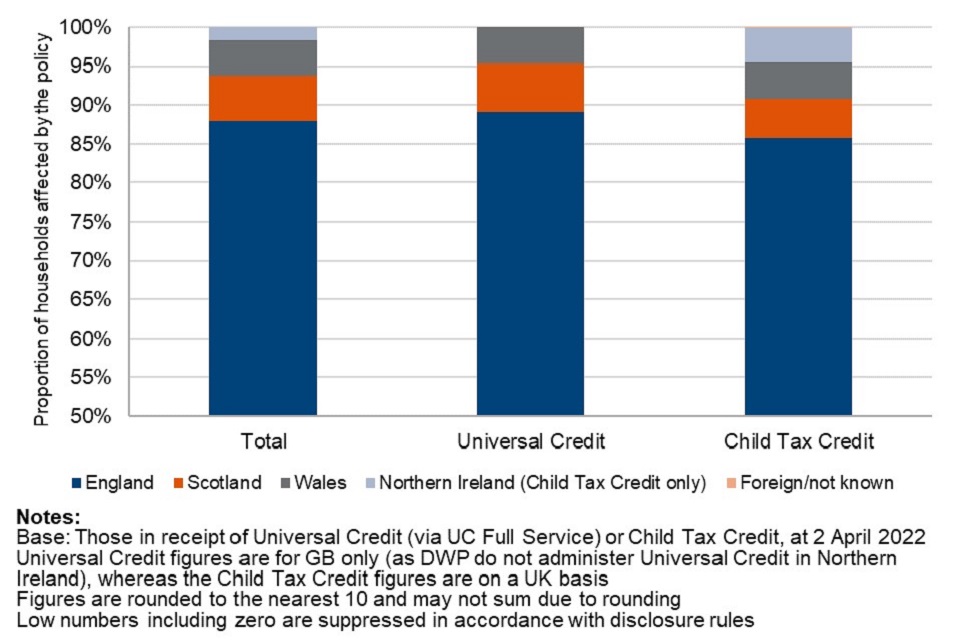
Households with an exception to the policy to provide support for a maximum of two children, by country and exception category
Across all countries of the UK, as of 2 April 2022, households with a multiple birth were the most common type of exception, accounting for 71 per cent of Universal Credit or Child Tax Credit households with an exception in England, 69 per cent of households in Scotland, 69 per cent of households in Wales and 79 per cent of CTC households only in Northern Ireland (Figure 5). Given small population sizes it is not recommended to draw robust conclusions from the differing proportions of households with other types of exceptions by country at this point in time, due to both rounding and the suppression of small numbers of cases. As noted earlier, in future years the numbers affected by the policy, and the numbers of exceptions, are expected to increase.
These figures reflect areas of responsibility of the Department for Work and Pensions and HM Revenue & Customs. Consequently, UC statistics relate to Great Britain whereas statistics on CTC relate to the United Kingdom.
Figure 5: Proportion of households with an exception to the policy in each country by exception category, 2 April 22

Households affected by the policy to provide support for a maximum of two children, by region
There are 12 first level regions in the UK, 9 such regions in England, together with Scotland, Wales, and Northern Ireland. The region of London contains the largest number of households that are affected by the policy with a total of 55 thousand households being affected (Figure 6). Within GB, the North East contains the lowest number of households affected by the policy with a total of 16 thousand households affected. Child Tax Credit claimants are the only households that can be affected by the policy in Northern Ireland, which consequently contains the lowest number of households affected by the policy in the UK with a total of 6 thousand.
The proportion of households not receiving a child element/amount for all regions lies between 96 and 98 per cent of all households affected by the policy, with no clear disparities between regions (Figure 7). Similarly, the proportion of households with an exception lies between 4 and 6 per cent of all households affected across all regions. A consistent 2 per cent of all households affected across each region are both not receiving a child element/amount for at least one third or subsequent child, and have an exception for at least one other child.
There are a small number of households (9 thousand) in the Universal Credit data where the region could not be identified. Since the Department for Work and Pensions cannot accurately assume the region of these claimants, they have been represented by the “Unknown” category.
These figures reflect areas of responsibility of the Department for Work and Pensions and HM Revenue & Customs. Consequently, UC statistics relate to Great Britain whereas statistics on CTC relate to the United Kingdom.
Figure 6: Number of households affected by the policy to provide support for a maximum of two children, by region, 2 April 2022

Figure 7: Proportion of households affected by the policy to provide support for a maximum of 2 children, by region, 2 April 2022
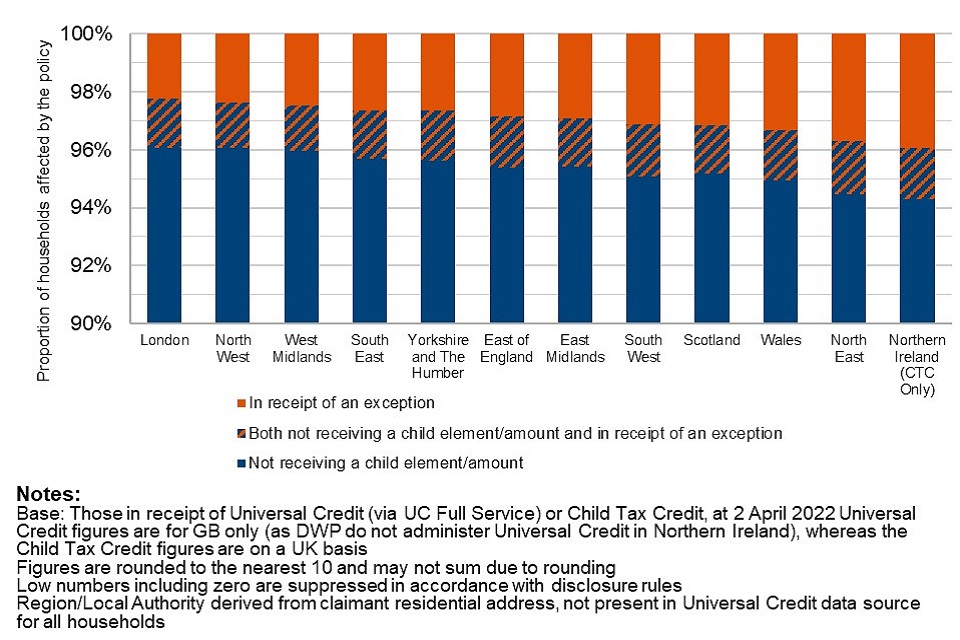
Households with an exception to the policy to provide support for a maximum of two children, by region and category
There are 12 first level regions in the UK, 9 such regions in England, together with Scotland, Wales, and Northern Ireland. In line with the national picture, the most common exception across all regions is the multiple birth exception whilst the least common exception is adoption. The two regions with the largest number of households with exceptions to the policy are London and the North West (with 2.2 thousand), whereas Wales has the fewest with 800 (Figure 8).
There are a small number of households (550) in the UC data where the region could not be identified. Since the Department for Work and Pensions cannot accurately assume the region of these claimants, they have been represented by the “Unknown” category.
These figures reflect areas of responsibility of the Department for Work and Pensions and HM Revenue & Customs. Consequently, UC statistics relate to Great Britain whereas statistics on Child Tax Credit relate to the United Kingdom.
Figure 8: Number of households with an exception to the policy to provide support for a max of 2 children, by region, 2 April 2022
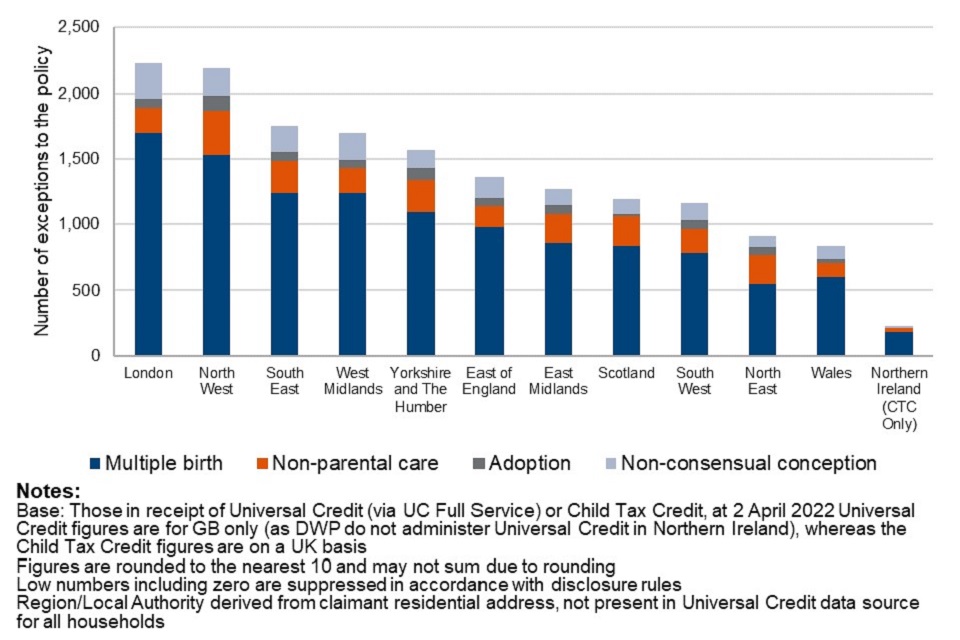
Overall numbers of households affected by the policy to provide support for a maximum of two children, not receiving a child element/amount for at least one child, by region and local authority
Across the UK, the proportion of households with three or more children on Universal Credit or Child Tax Credits that do not receive a child element/amount for at least one child is 46 per cent. For UC households only the proportion is 56 per cent, and for CTC households only the proportion is 34 per cent. This is because Universal Credit has a higher proportion of households with younger children than Child Tax Credit households.
As of 2nd April 2022, there are 363 local authorities in GB (in the UK there are 374 due to the inclusion of Northern Ireland), which vary largely by population. Birmingham, the largest of these, has the highest number of households with three or more children on UC or CTC, at 30 thousand, and also the highest number of households on UC or CTC not receiving an element/amount for one or more children, over 13 thousand. As a proportion of these volumes, at 45 per cent Birmingham matches closely with the UK average.
At 54 per cent, Hackney has the highest proportion of households with three or more children on Universal Credit or Child Tax Credits that do not receive a child element/amount for at least one child. Hackney and the 4 other highest proportion local authorities are visible in blue in Figure 9.
At 35 per cent, Oadby and Wigston has the lowest proportion of households with three or more children on Universal Credit or Child Tax Credits that do not receive a child element/amount for at least one child. Oadby and Wigston and the 4 other lowest proportion local authorities are visible in orange in Figure 9.
As figures for Northern Ireland are for Child Tax Credits only, the proportion of households with three or more children on Universal Credit or Child Tax Credits that do not receive a child element/amount for at least one child for Northern Irish local authorities (35 per cent) are lower than for English, Scottish, or Welsh local authorities, however this is consistent with other proportions when looking at CTC households only.
The region and local authority information is derived from the claimant residential address, and this cannot be identified for all households within the Universal Credit data source. Therefore, there are a small number of households with an “Unknown” region and local authority.
These figures reflect areas of responsibility of the Department for Work and Pensions and HM Revenue & Customs. Consequently, UC statistics relate to Great Britain whereas statistics on Child Tax Credit relate to the United Kingdom.
Figure 9: Proportion of households with three or more children that are not receiving an element or amount for at least one child, by Local Authority, 2 April 2022

Households affected by the policy to provide support for a maximum of two children, by number of children
Out of 370 thousand households affected by the policy, 224 thousand have three children, 96 thousand have four children and 50 thousand have five or more children (Figure 10).
The majority of households affected by the policy, 61 per cent, contain three children, with 26 per cent containing four children. The remaining 14 per cent are households with five or more children. The proportion of three child households is lower in Child Tax Credit (52 per cent) than in Universal Credit (65 per cent). This may reflect the population of UC at this stage of the rollout and the way this policy has been implemented.
Overall, there are around 1.3 million children in households affected by the policy (Figure 11), with 50 per cent in households with three children. 29 per cent are in households with four children, with the remaining 21 per cent being in households with five or more children.
Figure 10: Number of households affected by the policy to provide support for a maximum of two children, by size of family, 2 April 2022

Figure 11: Number of children living in households affected by the policy to provide support for a maximum of two children, by size of family, 2 April 2022
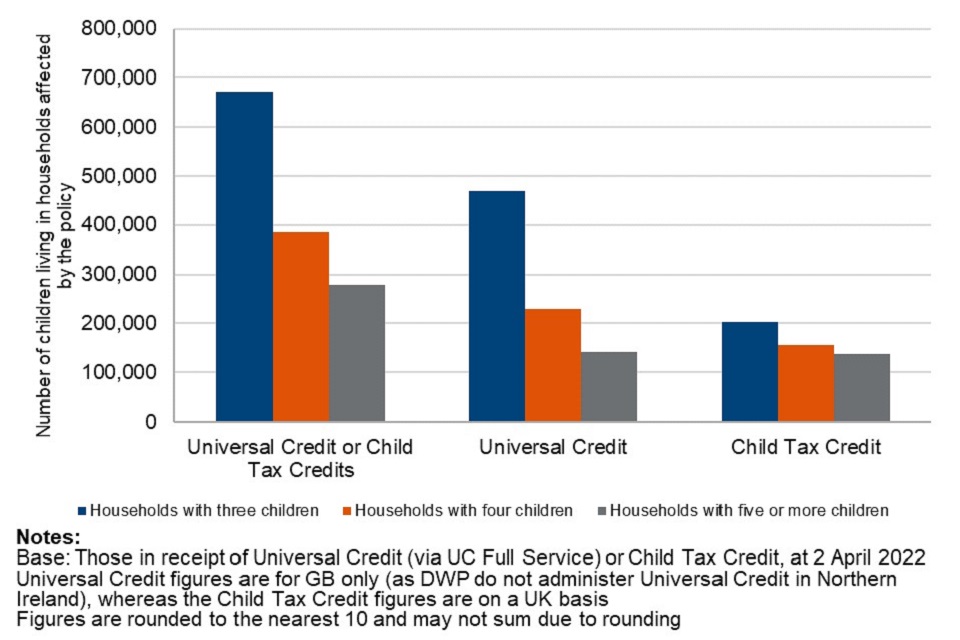
Overall numbers of households affected by the policy to provide support for a maximum of two children, by year
There has been a net increase of 52 thousand as of 2 April 2022 of the number of households in receipt of Universal Credit or Child Tax Credit affected by the policy to provide support for a maximum two children since the last publication (Figure 12). UC increased by 61 thousand while CTC fell by 9 thousand. This trend is expected as new claimants cannot apply for CTC and must instead apply for UC.
Figure 12: Number of households affected by the policy to provide support for a maximum of two children, by year

The total number of households with three or more children on 2 April 2022, including children born before 6 April 2017, reduced from 836 thousand to 787 thousand households (Figure 13). Whilst the number of households with three or more children is going up in UC as expected, the overall fall in these figures is due to the reduction over the past year in CTC households with three or more children, which fell by 104 thousand.
Figure 13: All households in receipt of Child Tax Credit or Universal Credit with three or more children, by year
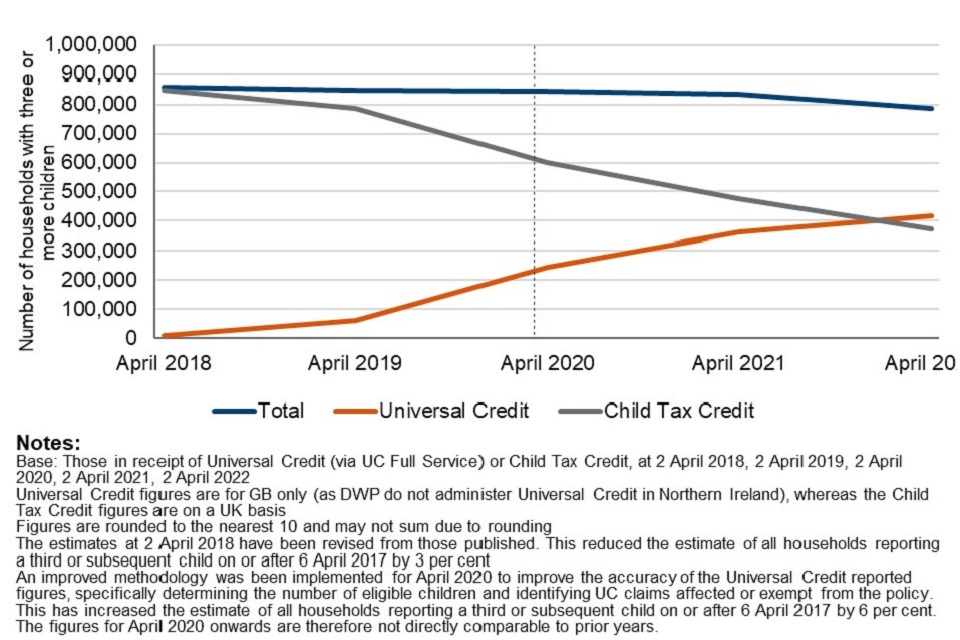
Feedback
We welcome feedback.
We are committed to improving the official statistics we publish. We want to encourage and promote user engagement, so we can improve our statistical outputs. We would welcome any views you have using the contact information below:
DWP Press Office: 0115 965 8781
Statistical contacts:
A Mays, S Lewis, M Clisham: ucad.briefinganalysis@dwp.gov.uk
O Jasper, D Bailey: benefitsandcredits.analysis@hmrc.gov.uk
